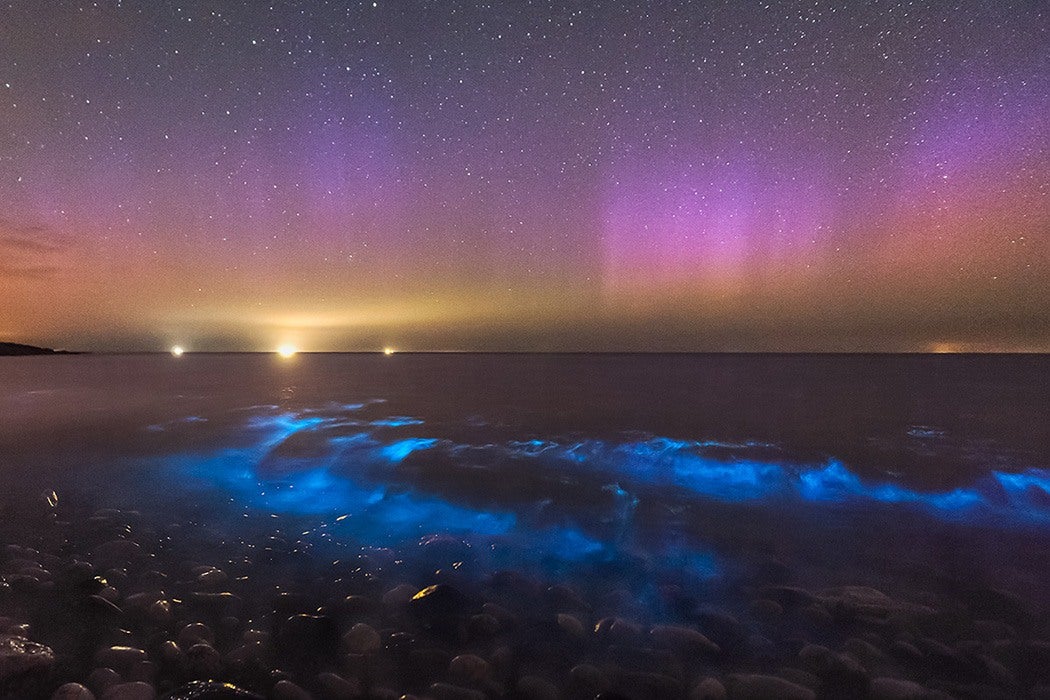Several years ago, I spent some time managing a lodge deep in the Ecuadorean cloud forest. Once, after fixing an especially obstinate clog in the water system, I found myself stranded on the mountain after sunset, without a headlamp, with several miles of steep, narrow trail between me and the lodge. Imagining worst-case scenarios (a tumble down the mountainside, a broken ankle far from medical help), I considered spending the night up on the mountain rather than braving a return hike. As I weighed my options, I noticed that the path itself wasn’t actually dark. All along the sheer bank beside the trail, glowing fungi attached to tree roots illuminated the path with a dim, greenish light. I made it back that night without falling off the mountain. Years later, I can still see the eerie spectacle of those glowing roots lighting my way home.
One of the most fascinating aspects of bioluminescence is the fact that it exists exclusively in the lower branches of the tree of life. Although no bird, reptile, or mammal has bioluminescent capabilities, other groups of organisms—fungi, bacteria, insects, fish—have developed the ability to create and use light in a variety of ways. Even some of the world’s simplest organisms, like marine plankton, have light-generating capabilities that are missing in advanced vertebrates (try diving off a dock along the north Atlantic coast on a summer night). Some have their own bioluminescent cells, which contain a specialized chemical called luciferin that reacts with oxygen to create light. Others maintain colonies of bioluminescent bacteria, which they can control to create specialized lighting patterns. Despite all the advanced tools in the Swiss army knife of the human body, we’re disappointingly dim when it comes to light production.
Fireflies are probably the best-known producers of bioluminescence, simply because they’re the most visible. Synchronous light displays, in which thousands of individuals produce complicated light patterns in unison with almost no error, have long been a source of fascination for biologists. These displays aren’t unique to fireflies. In the western Caribbean, tiny, transparent crustaceans called ostracods engage in courtship displays in which males light up sequentially, forming staggered patterns of brilliant blue light that trail through the water. Indeed, bioluminescence is especially common in dimly-lit marine environments, where it serves as a means of visual communication.
While the most widely recognized examples of bioluminescence involve light as a signaling or attention-drawing mechanism, organisms also can use light to conceal and distract. In the deep ocean, where creatures swimming higher in the water column appear as dark shadows to those below, some species camouflage themselves by disguising their undersides with blue light. This light makes them invisible against the light of the sky, or allows them to imitate other animals by concealing certain parts of their bodies. Squid can use bursts of light to blind or distract predators, allowing them to escape, and predators tend to avoid flashing plankton. There’s even evidence that some species of insects imitate the light patterns of other species, to lure prey or make themselves less appealing to predators, although that evidence is limited and debatable.
Weekly Newsletter
Strangely enough, besides lacking bioluminescent capabilities, humans have not progressed very far in our attempts to harness the power of luciferin for ourselves. Although jars of fireflies were once used as light sources in locations where open flames were dangerous, like coal mines, these artisanal lighting systems were never attempted on a larger scale. Military operations to develop chemical lights that mimicked bioluminescence also didn’t progress very far. Instead, recent research has settled on a less obvious use for natural light production: in biomedical science. To track how genes are replicated and move between cells, researchers often use “reporter genes”—extra proteins that can be attached to the gene of interest like ID tags. Studies have found that particular bioluminescent proteins, derived from fireflies and colonial jellyfish, make it much easier to observe patterns of gene expression.
Given the difficulty of translating bioluminescence into industrial-scale lighting technologies, it looks like the only self-lighting in our future will be at the microscopic level. I don’t mind. In a way, it’s nice to know there’s one superpower that we’ve never been able to harness for ourselves.







